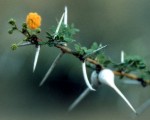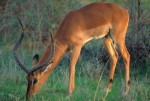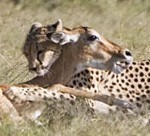 |
These defenses include mechanical protections on the surface of the plant, production of complex polymers that reduce plant digestibility to animals, and the production of toxins that kill or repel herbivores. Defenses can either be constitutive, always present in the plant, or induced, produced or translocated by the plant following damage or stress. The term host plant resistance is also used by plant breeders to refer to these mechanisms.
Plants have also evolved features that enhance the probability of attracting natural enemies to herbivores. Specifically, they emit semiochemicals, odors that attract natural enemies, and provide food and housing to maintain the natural enemies’ presence.
A given plant species often has many types of defensive mechanisms, mechanical or chemical, constitutive or induced, which additively serve to protect the plant, and allow it to escape from herbivores.
 |
Herbivore adaptations to defences: Herbivores are dependent on plants for food, and have coevolved mechanisms to obtain this food despite the evolution of a diverse arsenal of plant defenses against herbivory. Herbivores adaptations to plant defense have been likened to "offensive traits" and consist of those traits that allow for increased feeding and use of a host. Plants, on the other hand, protect their resources for use in growth and reproduction, by limiting the ability of herbivores to eat them.
Relationships between herbivores and their host plants often result in reciprocal evolutionary change. When an herbivore eats a plant it selects for plants that can mount a defensive response, whether the response is incorporated biochemically or physically, or induced as a counterattack. In cases where this relationship demonstrates "specificity" (the evolution of each trait is due to the other), and "reciprocity" (both traits must evolve), the species are thought to have coevolved. Reciprocal adaptations in herbivores and their host plants has been one of the driving forces behind speciation.
 |
Very young individuals also tend to be targets of predators. Examination of the life history of animals, even in the absence of predation, indicates that the highest rates of mortality occur in the very young ages and the very old ages. From that perspective, predators tend to remove individuals with a relatively large chance of dying from other causes and, thereby, promote the survival of remaining members of the prey population.